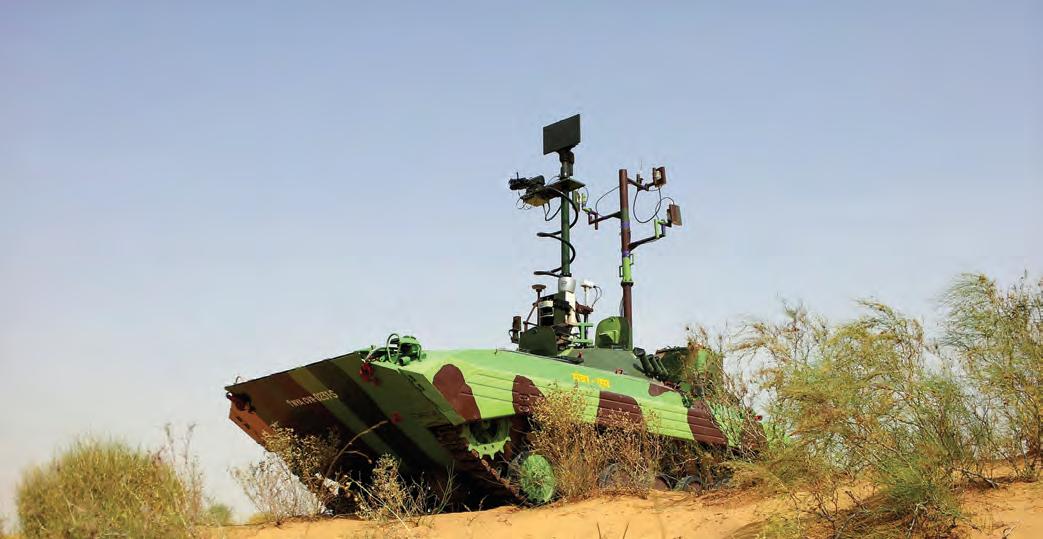Try GOLD - Free
THE RISE OF UGVs REVOLUTIONISING TACTICAL AND STRATEGIC MILITARY OPERATIONS
Geopolitics
|January 2025
MANOJ K CHANNAN explains the history of UGVs, their role in modern warfare, their integration with advanced technologies, and their broader implications for military operations, intelligence assessments, and human-machine collaboration

The nature of warfare has undergone a dramatic transformation over the last century, with rapid technological advancements reshaping the roles of soldiers, machines, and decision-making processes on the battlefield. Unmanned Ground Vehicles (UGVs) are emerging as indispensable tools for modern militaries in this new era. Integrated with cutting-edge technologies such as Artificial Intelligence (AI), Machine Learning (ML), Internet of Things (IoT), and Quantum Computing, UGVs have the potential to revolutionise how military operations are conducted, enabling faster, safer, and more efficient outcomes.
UGVs, equipped with machinedriven precision and real-time data processing, reduce human risk while improving battlefield awareness and operational efficiency. Future battles will increasingly rely on these autonomous systems to compress decision-making timelines, outwit adversaries, and ensure dominance in strategic and tactical engagements. However, alongside these opportunities lie significant challenges, including cybersecurity vulnerabilities, ethical dilemmas, and concerns over the over-reliance on automation.
Historical Background
The roots of Unmanned Ground Vehicles can be traced back to World War II when the German military developed the Goliath tracked mine—a small, remote-controlled vehicle designed for demolition tasks. Despite its innovative concept, technological limitations such as poor communication systems and limited power supply restricted its effectiveness. This historical context connects us to the past and helps us appreciate our significant strides in UGV technology.
During the Cold War, unmanned systems gained renewed interest, but the focus remained primarily on Unmanned Aerial Vehicles (UAVs). Ground vehicles were still seen as impractical due to the complexities of terrain navigation and lack of autonomous control.
This story is from the January 2025 edition of Geopolitics.
Subscribe to Magzter GOLD to access thousands of curated premium stories, and 10,000+ magazines and newspapers.
Already a subscriber? Sign In
MORE STORIES FROM Geopolitics

Geopolitics
HERNE® - A MILITARY CAPABLE AND ASSURED XLAUV
Herne is a modular, highly configurable Extra Large Autonomous Underwater Vehicle (XLAUV); a military capability at the forefront of the underwater battlespace.
3 mins
November 2025

Geopolitics
ICEYE LAUNCHES TACTICAL ACCESS, PROVIDING GUARANTEED SATELLITE TASKING FOR TIME-CRITICAL MISSIONS
ICEYE's Tactical Access is the only commercial SAR service providing guaranteed imaging slots, sub-hour delivery, and sovereign in-country processing - ensuring defence and intelligence organisations receive critical imagery when and where it's needed.
2 mins
November 2025

Geopolitics
RUSSIA MATTERS
An abiding military relationship with Russia is essential for India
10 mins
November 2025
Geopolitics
A REVOLUTIONARY MULTI ROLE SOFTWARE DEFINED RADIO BY ASTRA RAFAEL COMSYS
Astra Rafael Comsys Pvt Ltd (ARC), a joint venture between Astra Microwave Products Ltd, India, and Rafael Advanced Defence Systems, Israel, leads battlefield communications innovation as India's first private manufacturer of in-service military-grade Software Defined Radios, equipping the Indian Army and Special Forces with advanced tactical solutions
2 mins
November 2025

Geopolitics
THE INDIAN AIR FORCE AIMS AT BEING 'FUTURE READY' THROUGH THE STEPS OF 'NOW READY' - IAF CHIEF
Commissioned into the fighter stream of the Indian Air Force on 21 Dec 1984, AP SINGH PVSM AVSM took over as the 28th Chief of the Air Staff (CAS) on 30th September 2024. He is an alumnus of the National Defence Academy, Defence Services Staff College and National Defence College. He is a Qualified Flying Instructor and an Experimental Test Pilot with more than 5000 hours of service flying on a variety of fixed and rotary wing aircraft.
7 mins
November 2025

Geopolitics
A SLICE OF HISTORY
The Zardari Presidency: An Insider's Account is an essential read for understanding Pakistani politics from 2008 to 2013, offering a fresh perspective that challenges prevailing media narratives by providing context, behind-the-scenes insights, and candid assessments of the era's complexities and challenges.
9 mins
November 2025

Geopolitics
CREATING A UAV FOR THE WORLD
BonV Aero aims to be a global supplier of cost-effective, indigenous heavy-lift UAVs designed for extreme altitudes, harsh weather, and rugged terrains, offering competitively priced, exportcontrol-free drones built in India for countries with challenging geographies like mountainous borders and disaster-prone areas. SATYABRATA SATAPATHY, Co-Founder and CEO, BonV Aero, outlines their vision
3 mins
November 2025
Geopolitics
MILITARISATION OF SATELLITE TECHNOLOGY
If anything, satellite imaging company Vantor signing recently a contract with the U.S. Space Force to help run a \"neighbourhood watch\" in space to monitor for space-based threats like rogue satellites or debris that ground sensors may miss has reconfirmed a growing trend.
4 mins
November 2025

Geopolitics
ATMANIRBHAR BHARAT AND ISRAELI EXPERTISE: A BLUEPRINT FOR COLLABORATIVE DEFENCE MANUFACTURING
IWI (Israel Weapon Industries) recognises India as a strategic partner, exemplified by its joint venture with Adani Group in PLR Systems, India's first private-sector small arms manufacturing facility established under Atmanirbhar Bharat and a model for high-impact defence collaboration. SHUKI SCHWARTZ, CEO of IWI (Israel Weapon Industries) and a Board Director of PLR, outlines the vision behind the collaboration
3 mins
November 2025

Geopolitics
INDIA'S ASSERTIVE DIPLOMACY
Amidst global strategic uncertainty and instability, the Indian armed forces continue to participate in a wide gamut of joint exercises with various foreign militaries
7 mins
November 2025
Listen
Translate
Change font size

